Seated Liberty Half Dime Values
How Much Seated Liberty Half Dimes are Worth: Seated Liberty Half Dime Values & Coin Price Chart
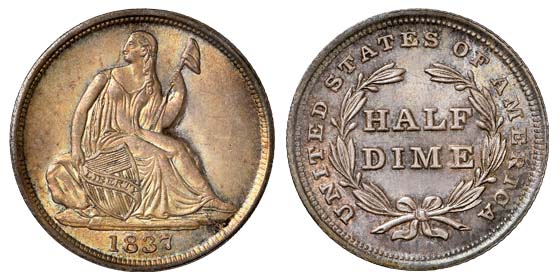
Year | Mint | Variety | Designation | VG-8 | F-12 | VF-20 | EF-40 | AU-50 | U-60 | MS-63 | MS-64 | MS-65 | MS-66 | MS-67 |
|---|---|---|---|---|---|---|---|---|---|---|---|---|---|---|
1800 | P | Plain 4- Stemless Wreath | Red-brown | 200 | 300 | 400 | 500 | 600 | 700 | 800 | 900 | 1000 | 1200 | 1100 |
| Year | Mint | Variety | Designation | VG-8 | F-12 | VF-20 | EF-40 | AU-50 | MS-60 | MS-63 | MS-64 | MS-65 | MS-66 |
|---|---|---|---|---|---|---|---|---|---|---|---|---|---|
| 1837 | (None) Phil | Large Date | -- | $81 | $122 | $190 | $327 | $484 | $830 | $1,278 | $1,469 | $2,600 | $4,340 |
| 1837 | (None) Phil | Small Date | -- | $81 | $122 | $190 | $327 | $484 | $844 | $1,320 | $1,524 | $2,738 | $4,920 |
| 1838 | O | -- | -- | $324 | $623 | $1,096 | $2,677 | $4,175 | $6,888 | $13,000 | $18,800 | $29,875 | $49,500 |
| 1838 | (None) Phil | No Drapery | -- | $48 | $59 | $81 | $150 | $226 | $402 | $628 | $969 | $1,605 | $2,603 |
| 1838 | (None) Phil | Small stars | -- | $76 | $102 | $160 | $260 | $338 | $803 | $1,288 | $1,868 | $3,845 | $5,975 |
| 1839 | (None) Phil | -- | -- | $48 | $59 | $81 | $150 | $226 | $415 | $656 | $969 | $1,660 | $2,878 |
| 1839 | O | -- | -- | $49 | $61 | $91 | $244 | $454 | $1,315 | $2,255 | $4,263 | $10,500 | $18,950 |
| 1840 | (None) Phil | Drapery | -- | $100 | $146 | $180 | $260 | $346 | $545 | $1,052 | $1,813 | $2,768 | $8,300 |
| 1840 | O | Drapery | -- | $205 | $297 | $465 | $866 | $1,715 | $7,275 | $23,925 | $31,250 | -- | -- |
| 1840 | O | No Drapery | -- | $201 | $271 | $343 | $639 | $780 | $2,130 | $5,920 | $12,450 | $18,675 | $19,800 |
| 1840 | (None) Phil | No Drapery | -- | $48 | $59 | $81 | $150 | $226 | $402 | $628 | $969 | $1,660 | $3,015 |
| 1841 | (None) Phil | -- | -- | $40 | $48 | $58 | $82 | $148 | $230 | $357 | $598 | $1,065 | $1,688 |
| 1841 | O | -- | -- | $127 | $173 | $280 | $368 | $468 | $1,300 | $2,780 | $3,845 | $8,575 | $13,000 |
| 1842 | (None) Phil | -- | -- | $40 | $48 | $55 | $82 | $148 | $296 | $490 | $753 | $1,398 | $2,377 |
| 1842 | O | -- | -- | $162 | $273 | $472 | $753 | $1,068 | $1,638 | $2,365 | $5,090 | $14,800 | $23,500 |
| 1843 | (None) Phil | -- | -- | $40 | $48 | $58 | $82 | $148 | $238 | $465 | $803 | $1,592 | $2,380 |
| 1844 | (None) Phil | -- | -- | $41 | $49 | $63 | $121 | $208 | $388 | $620 | $775 | $1,328 | $1,770 |
| 1844 | O | -- | -- | $251 | $382 | $780 | $1,660 | $2,600 | $7,550 | $11,200 | $16,600 | $24,750 | -- |
| 1845 | (None) Phil | -- | -- | $40 | $48 | $58 | $82 | $148 | $241 | $440 | $714 | $1,087 | $1,535 |
| 1846 | (None) Phil | -- | -- | $1,467 | $2,005 | $2,820 | $4,840 | $7,738 | $21,150 | $48,100 | -- | -- | -- |
| 1847 | (None) Phil | -- | -- | $40 | $48 | $58 | $82 | $148 | $233 | $363 | $650 | $1,273 | $2,490 |
| 1848 | (None) Phil | Medium Date | -- | $40 | $48 | $58 | $95 | $173 | $377 | $617 | $1,715 | $2,738 | $4,290 |
| 1848 | (None) Phil | Large Date | -- | $60 | $99 | $155 | $247 | $445 | $913 | $1,843 | $2,625 | $5,475 | $15,750 |
| 1848 | O | -- | -- | $58 | $76 | $122 | $247 | $390 | $675 | $1,190 | $1,840 | $2,905 | $4,150 |
| 1849 | (None) Phil | -- | -- | $40 | $48 | $58 | $82 | $148 | $310 | $670 | $1,065 | $1,770 | $2,713 |
| 1849/6 | (None) Phil | -- | -- | $91 | $130 | $148 | $241 | $390 | $830 | $1,273 | $1,688 | $2,518 | $4,150 |
| 1849/6 | (None) Phil | 9 Over Widely Placed 6 | -- | $98 | $143 | $176 | $266 | $390 | $935 | $1,688 | $2,075 | $3,320 | -- |
| 1849/6 | (None) Phil | Overdate FS-302 (001.55) | -- | $125 | $175 | $225 | $350 | $450 | $1,100 | $2,000 | $2,500 | $4,000 | -- |
| 1849 | O | -- | -- | $191 | $285 | $385 | $700 | $1,120 | $2,615 | $3,955 | $6,280 | $10,375 | $14,800 |
| 1850 | (None) Phil | -- | -- | $40 | $48 | $58 | $82 | $148 | $230 | $357 | $595 | $885 | $2,009 |
| 1850 | O | -- | -- | $41 | $54 | $82 | $186 | $299 | $803 | $1,813 | $4,425 | $6,250 | $9,125 |
| 1851 | (None) Phil | -- | -- | $40 | $48 | $58 | $82 | $148 | $249 | $390 | $595 | $1,065 | $1,660 |
| 1851 | O | -- | -- | $43 | $51 | $68 | $151 | $274 | $545 | $990 | $1,895 | $4,065 | $6,750 |
| 1852 | (None) Phil | -- | -- | $40 | $48 | $58 | $82 | $148 | $230 | $357 | $609 | $1,079 | $1,300 |
| 1852 | O | -- | -- | $96 | $140 | $202 | $363 | $567 | $1,273 | $3,070 | $5,975 | $8,960 | $15,075 |
| 1853 | (None) Phil | No Arrows | -- | $99 | $160 | $226 | $388 | $573 | $830 | $1,343 | $1,758 | $2,255 | $3,100 |
| 1853 | O | No Arrows | -- | $623 | $1,038 | $1,563 | $3,070 | $4,538 | $11,475 | $17,150 | $26,000 | $35,400 | -- |
| 1853 | (None) Phil | Arrows | -- | $40 | $50 | $55 | $95 | $180 | $238 | $368 | $540 | $1,024 | $1,605 |
| 1853 | O | Arrows | -- | $46 | $54 | $68 | $137 | $208 | $498 | $1,245 | $1,978 | $5,200 | $7,110 |
| 1854 | (None) Phil | Arrows | -- | $50 | $48 | $55 | $95 | $148 | $238 | $368 | $665 | $1,274 | $2,075 |
| 1854 | O | Arrows | -- | $40 | $49 | $63 | $117 | $229 | $465 | $885 | $1,730 | $3,928 | $6,225 |
| 1855 | (None) Phil | Arrows | -- | $40 | $48 | $55 | $95 | $148 | $238 | $393 | $590 | $1,453 | $4,425 |
| 1855 | O | Arrows | -- | $41 | $57 | $200 | $208 | $288 | $875 | $1,268 | $2,380 | $5,725 | $10,650 |
| 1856 | (None) Phil | -- | -- | $50 | $48 | $58 | $82 | $148 | $230 | $357 | $584 | $706 | $1,038 |
| 1856 | O | -- | -- | $40 | $49 | $62 | $135 | $260 | $545 | $971 | $1,480 | $2,463 | $5,200 |
| 1857 | (None) Phil | -- | -- | $40 | $48 | $75 | $82 | $148 | $230 | $357 | $584 | $706 | $1,038 |
| 1857 | O | -- | -- | $48 | $55 | $60 | $104 | $201 | $415 | $639 | $1,065 | $1,245 | $2,020 |
| 1858 | (None) Phil | -- | -- | $40 | $48 | $58 | $82 | $200 | $230 | $357 | $584 | $706 | $1,038 |
| 1858 | (None) Phil | Over Inverted Date | -- | $123 | $163 | $215 | $367 | $424 | $1,038 | $1,965 | $4,013 | $5,175 | $9,550 |
| 1858 | O | -- | -- | $43 | $50 | $60 | $113 | $161 | $324 | $493 | $725 | $1,329 | $2,075 |
| 1859 | O | -- | -- | $48 | $75 | $104 | $182 | $262 | $440 | $595 | $1,052 | $1,480 | $3,570 |
| 1859 | (None) Phil | -- | -- | $40 | $49 | $59 | $85 | $154 | $249 | $390 | $617 | $783 | $1,038 |
| 1860 | (None) Phil | -- | -- | $40 | $46 | $52 | $72 | $114 | $233 | $357 | $498 | $675 | $1,038 |
| 1860 | O | -- | -- | $42 | $49 | $56 | $86 | $136 | $288 | $520 | $853 | $1,177 | $2,365 |
| 1861 | (None) Phil | -- | -- | $42 | $48 | $54 | $72 | $114 | $233 | $357 | $498 | $675 | $1,190 |
| 1861 | (None) Phil | 1/0' | -- | $61 | $99 | $146 | $260 | $335 | $592 | $780 | $1,300 | $1,853 | $3,003 |
| 1862 | (None) Phil | -- | -- | $40 | $46 | $52 | $72 | $114 | $233 | $357 | $498 | $675 | $1,038 |
| 1863 | (None) Phil | -- | -- | $314 | $401 | $447 | $562 | $664 | $858 | $1,049 | $1,204 | $1,715 | $2,283 |
| 1863 | S | -- | -- | $94 | $143 | $184 | $310 | $493 | $858 | $1,218 | $1,825 | $4,233 | $5,588 |
| 1864 | (None) Phil | -- | -- | $592 | $874 | $1,024 | $1,224 | $1,303 | $1,455 | $1,660 | $2,048 | $2,600 | $3,650 |
| 1864 | S | -- | -- | $178 | $241 | $330 | $570 | $761 | $1,065 | $1,660 | $2,905 | $4,370 | $9,275 |
| 1865 | S | -- | -- | $98 | $143 | $205 | $388 | $675 | $1,273 | $2,600 | $3,900 | $8,575 | $20,750 |
| 1865 | (None) Phil | -- | -- | $532 | $761 | $852 | $1,077 | $1,218 | $1,423 | $1,605 | $1,738 | $2,850 | $3,375 |
| 1866 | (None) Phil | -- | -- | $498 | $720 | $793 | $974 | $1,035 | $1,213 | $1,376 | $1,475 | $2,988 | $3,928 |
| 1866 | S | -- | -- | $64 | $94 | $139 | $247 | $390 | $648 | $1,273 | $1,965 | $5,420 | $7,550 |
| 1867 | (None) Phil | -- | -- | $651 | $827 | $872 | $963 | $1,082 | $1,300 | $1,743 | $2,213 | $3,180 | $4,175 |
| 1867 | S | -- | -- | $98 | $143 | $180 | $272 | $342 | $775 | $1,234 | $2,103 | $3,430 | $6,225 |
| 1868 | (None) Phil | -- | -- | $117 | $179 | $236 | $332 | $443 | $700 | $1,010 | $1,287 | $1,480 | $2,600 |
| 1868 | S | -- | -- | $40 | $47 | $56 | $82 | $164 | $410 | $653 | $983 | $1,715 | $4,870 |
| 1869 | (None) Phil | -- | -- | $40 | $47 | $64 | $101 | $140 | $297 | $432 | $839 | $980 | $1,328 |
| 1869 | S | -- | -- | $40 | $47 | $77 | $137 | $211 | $454 | $1,163 | $2,075 | $4,260 | $7,000 |
| 1870 | S | -- | -- | -- | -- | -- | -- | -- | -- | -- | $3,400,000 | -- | -- |
| 1870 | (None) Phil | -- | -- | $40 | $46 | $52 | $72 | $114 | $233 | $357 | $607 | $935 | $1,660 |
| 1870 | (None) Phil | -- | Proof Like | -- | -- | -- | -- | -- | -- | -- | $1,250 | -- | -- |
| 1871 | (None) Phil | -- | -- | $40 | $46 | $50 | $72 | $140 | $233 | $357 | $498 | $675 | $1,213 |
| 1871 | S | -- | -- | $46 | $54 | $71 | $114 | $190 | $341 | $507 | $789 | $1,660 | $3,375 |
| 1872 | (None) Phil | -- | -- | $40 | $46 | $52 | $72 | $114 | $233 | $357 | $498 | $675 | $1,509 |
| 1872 | S | Mintmark Below Bow | -- | $40 | $46 | $52 | $72 | $114 | $233 | $407 | $573 | $775 | $1,190 |
| 1872 | S | Mintmark Above Bow | -- | $40 | $46 | $52 | $72 | $114 | $233 | $357 | $523 | $775 | $1,343 |
| 1873 | (None) Phil | -- | Proof Like | $40 | $46 | $52 | $72 | $114 | $233 | $357 | $498 | $1,080 | $2,020 |
| 1873 | S | -- | -- | $40 | $47 | $55 | $76 | $114 | $233 | $357 | $548 | $853 | $1,425 |
| 1968 | (None) Phil | -- | -- | -- | -- | -- | -- | -- | -- | -- | -- | -- | $5,500 |
Description and History
Although Capped Bust Half Dimes were minted in 1837, there was an impetus to change the design again. The task fell to Christian Gobrecht who was the Second (behind Chief) Engraver of the United States Mint. He had worked for the US Mint as early as 1823, but it was a temporary position. Gobrecht finally became the Chief Engraver in 1840 and held the position until his death in 1844.

The design was similar to his pattern of Silver dollars of 1835 and 1836 (the Gobrecht Dollars) and was simple in its presentation. The obverse of the coin had Liberty, seated, facing left, holding a shield in one hand and a pole with a cap on the end of it in the other. The only distraction to that symbolism was the date below Miss Liberty. The reverse had the denomination “HALF DIME” in two lines, enclosed inside a wreath with “UNITED STATES OF AMERICA” around it.
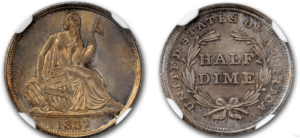
The 1837 coin was minted in Philadelphia and 1,405,000 were struck. There were two varieties – a Small Date and a Large Date, neither of them is particularly more valuable than the other. The only other coin issued a Variety One was an 1838-O struck in New Orleans, with only 70,000 coins actually minted. It is considerably rarer than either of the 1837 varieties.
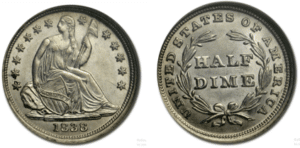
In 1838 the Philadelphia Mint added 13 stars above and around Miss Liberty and this was continued through 1859. The New Orleans “O” mintmark appears above the bow on the reverse. In 1840, a fold of drapery was added from the right elbow on Miss Liberty. Coins were struck in Philadelphia and New Orleans and the design was unchanged until 1853.
1838 dated coins come in both Large and Small star varieties with the latter being much more valuable. 2,225,000 1838-dated coins were minted in Philadelphia. 1839 saw over 1 million coins struck both at Philadelphia and New Orleans and they are valued similarly. Philadelphia struck over 1 million coins in 1840 and New Orleans struck under 700,000 coins that same year. The same pattern was repeated in 1841 with Philadelphia over 1 million coins and New Orleans just over 800,000. In 1842 the main mint struck 815,000 and the branch mint only 315,000.
No New Orleans coins were struck in 1843, while Philadelphia struck 815,000. In 1844 mintages dropped at both mints with Philadelphia striking 430,000 and New Orleans only striking 220,000 coins. Between 1845 and 1848, coins were only struck in Philadelphia. 1846 was a difficult year with only 27,000 minted making any half dime dated 1846 very scarce in any grade. 1849 saw over 1/3 million coins struck and 3 varieties were created – a normal date, a 9 over 6, and a 9 over a widely spaced 6. In New Orleans 140,000 were struck that same year. In both 1850 and 1851 coins were struck at both mints and the mintages were all under 1 million coins in all instances.
In 1852 and 1853 coins were once again struck at both mints. In 1852 over 1 million coins were struck at Philadelphia but the other 3 years and mintmarks were 260,000 or less, with the 1853-O being particularly rare in all grades! The 1853 coin has the lowest mintage with only 135,000 coins struck at Philadelphia that year of this particular type. But a new variety was about to be struck.
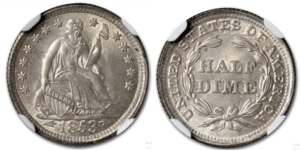
Later in the year 1853, arrows were placed on each side of the date to denote a reduction in the silver weight of the coins. This continued from 1853 through 1855 and applied to coins minted both in Philadelphia and New Orleans. 1853 from Philadelphia had the highest mintage at 13.2 million coins while the 1885-O had the lowest mintage with only 600,000 coins struck.
From 1856 to 1859, at both the Philadelphia and New Orleans mints Variety Two was resumed, meaning the coins no longer displayed arrows at the date, but the reduced weight of Variety Three remained as the standard weight. Mintages varied from a high of 7.3 million to a low of 340,000.
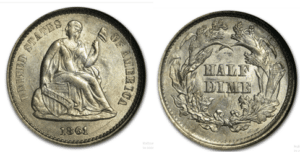
Variety Four coins began in 1860 and ran until the denomination was discontinued in 1873. As one would expect with the outbreak of the Civil War in 1861, New Orleans coins bearing the “O” mintmark were struck in 1860 and that was the final year. Between 1861 and 1865, New Orleans was located deep in the heart of the Confederate States of America and New Orleans ceased to be a valuable branch mint for the United States. To pick up the slack and assist Philadelphia in coin production, coins were struck in San Francisco beginning in 1863 and running through the end of production in 1873.
In 1978 a stunning event happened regarding these Liberty Seated Half Dimes. A collector purchased a coin in a dealer’s “junk box” that turned out to be a coin that did not exist. He located an 1870-S Liberty Seated Half Dime, of which the Mint had no records that the coin ever existed – yet there it was and it was examined and found to be genuine.

